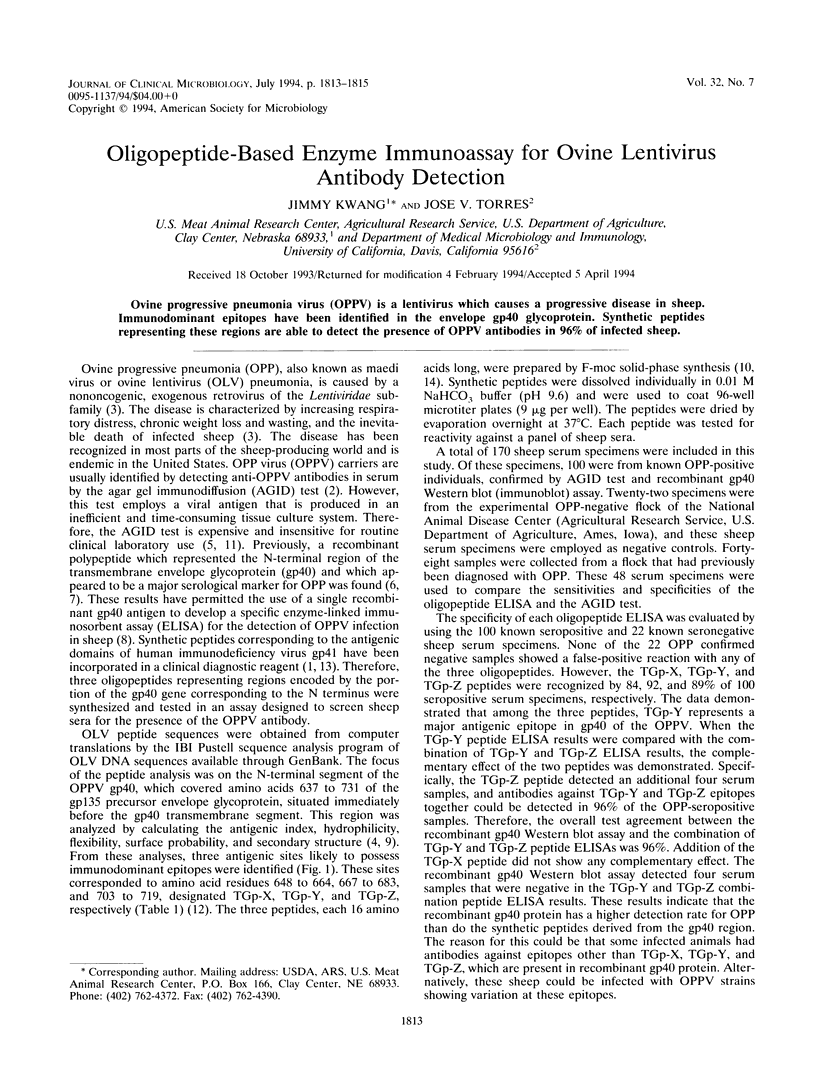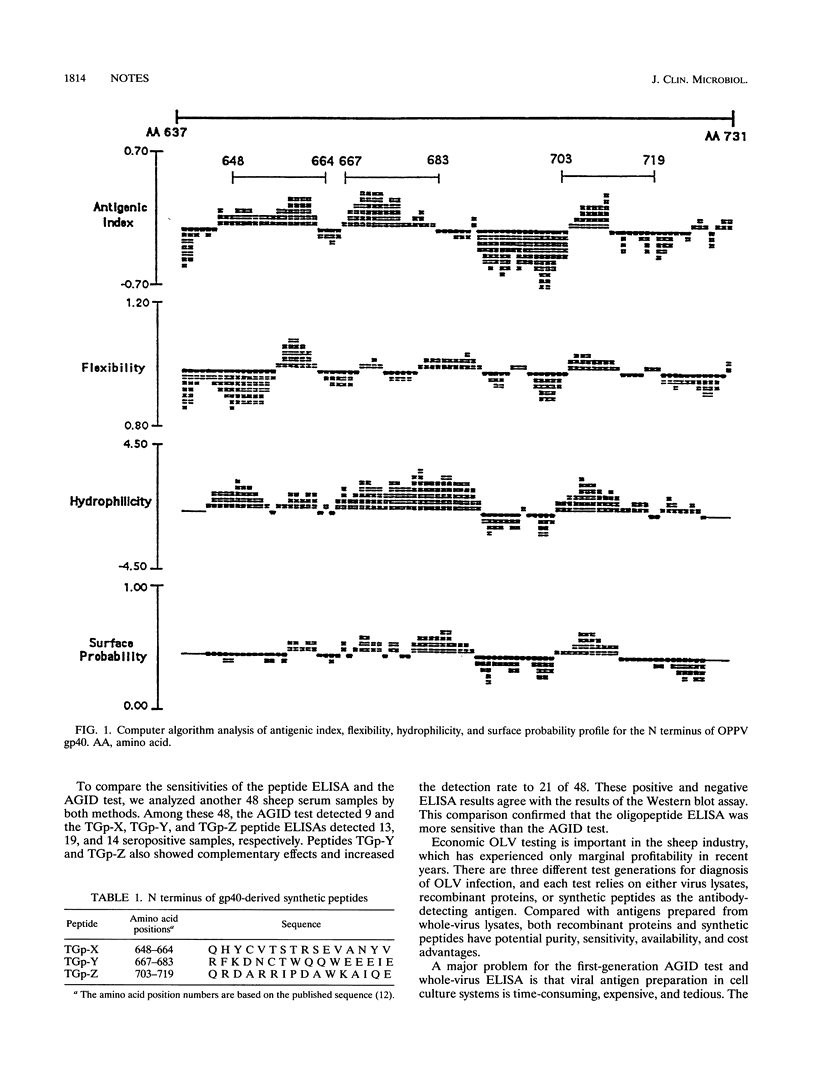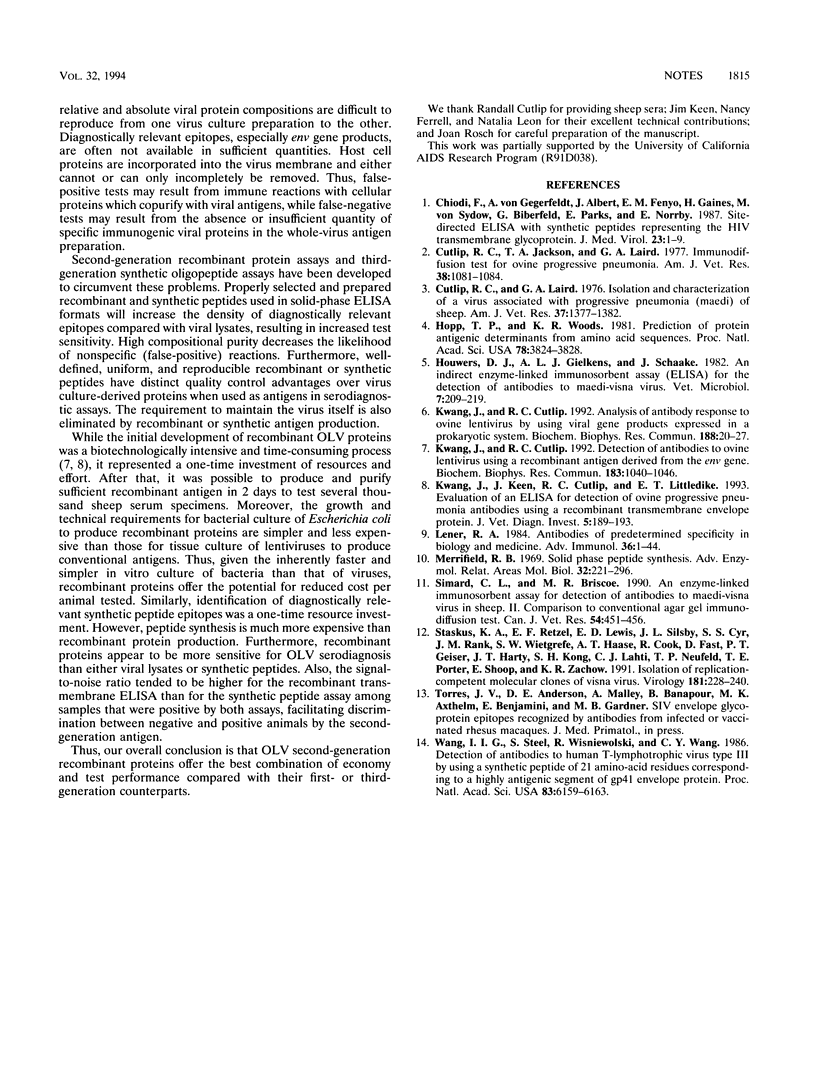Abstract
Ovine progressive pneumonia virus (OPPV) is a lentivirus which causes a progressive disease in sheep. Immunodominant epitopes have been identified in the envelope gp40 glycoprotein. Synthetic peptides representing these regions are able to detect the presence of OPPV antibodies in 96% of infected sheep.
Full text
PDF


Selected References
These references are in PubMed. This may not be the complete list of references from this article.
- Chiodi F., von Gegerfeldt A., Albert J., Fenyö E. M., Gaines H., von Sydow M., Biberfeld G., Parks E., Norrby E. Site-directed ELISA with synthetic peptides representing the HIV transmembrane glycoprotein. J Med Virol. 1987 Sep;23(1):1–9. doi: 10.1002/jmv.1890230102. [DOI] [PubMed] [Google Scholar]
- Cutlip R. C., Jackson T. A., Laird G. A. Immunodiffusion test for ovine progressive pneumonia. Am J Vet Res. 1977 Jul;38(7):1081–1084. [PubMed] [Google Scholar]
- Cutlip R. C., Laird G. A. Isolation and characterization of a virus associated with progressive pneumonia (maedi) of sheep. Am J Vet Res. 1976 Dec;37(12):1377–1382. [PubMed] [Google Scholar]
- Hopp T. P., Woods K. R. Prediction of protein antigenic determinants from amino acid sequences. Proc Natl Acad Sci U S A. 1981 Jun;78(6):3824–3828. doi: 10.1073/pnas.78.6.3824. [DOI] [PMC free article] [PubMed] [Google Scholar]
- Houwers D. J., Gielkens A. L., Schaake J., Jr An indirect enzyme-linked immunosorbent assay (ELISA) for the detection of antibodies to maedi-visna virus. Vet Microbiol. 1982 Jul;7(3):209–219. doi: 10.1016/0378-1135(82)90035-9. [DOI] [PubMed] [Google Scholar]
- Kwang J., Cutlip R. Analysis of antibody response to ovine lentivirus by using viral gene products expressed in a prokaryotic system. Biochem Biophys Res Commun. 1992 Oct 15;188(1):20–27. doi: 10.1016/0006-291x(92)92344-w. [DOI] [PubMed] [Google Scholar]
- Kwang J., Cutlip R. Detection of antibodies to ovine lentivirus using a recombinant antigen derived from the env gene. Biochem Biophys Res Commun. 1992 Mar 31;183(3):1040–1046. doi: 10.1016/s0006-291x(05)80295-5. [DOI] [PubMed] [Google Scholar]
- Kwang J., Keen J., Cutlip R. C., Littledike E. T. Evaluation of an ELISA for detection of ovine progressive pneumonia antibodies using a recombinant transmembrane envelope protein. J Vet Diagn Invest. 1993 Apr;5(2):189–193. doi: 10.1177/104063879300500208. [DOI] [PubMed] [Google Scholar]
- Lerner R. A. Antibodies of predetermined specificity in biology and medicine. Adv Immunol. 1984;36:1–44. doi: 10.1016/s0065-2776(08)60898-6. [DOI] [PubMed] [Google Scholar]
- Merrifield R. B. Solid-phase peptide synthesis. Adv Enzymol Relat Areas Mol Biol. 1969;32:221–296. doi: 10.1002/9780470122778.ch6. [DOI] [PubMed] [Google Scholar]
- Simard C. L., Briscoe M. R. An enzyme-linked immunosorbent assay for detection of antibodies to maedi-visna virus in sheep. II. Comparison to conventional agar gel immunodiffusion test. Can J Vet Res. 1990 Oct;54(4):451–456. [PMC free article] [PubMed] [Google Scholar]
- Staskus K. A., Retzel E. F., Lewis E. D., Silsby J. L., St Cyr S., Rank J. M., Wietgrefe S. W., Haase A. T., Cook R., Fast D. Isolation of replication-competent molecular clones of visna virus. Virology. 1991 Mar;181(1):228–240. doi: 10.1016/0042-6822(91)90488-w. [DOI] [PubMed] [Google Scholar]
- Wang J. J., Steel S., Wisniewolski R., Wang C. Y. Detection of antibodies to human T-lymphotropic virus type III by using a synthetic peptide of 21 amino acid residues corresponding to a highly antigenic segment of gp41 envelope protein. Proc Natl Acad Sci U S A. 1986 Aug;83(16):6159–6163. doi: 10.1073/pnas.83.16.6159. [DOI] [PMC free article] [PubMed] [Google Scholar]


